Content
On the territory of the Russian Federation, more than 300 varieties of potatoes of domestic and foreign selection are approved for use. Such a variety is not easy to understand. Experts recommend, when selecting a variety, to pay attention to whether it is present in the State Register and whether it is recommended for your climatic zone. Consider which varieties in Siberia have proved to be the most reliable, abundant and delicious.
The best potato varieties for Siberia
Despite the fact that Siberia is not like the homeland of the vegetable - Bolivia - the culture feels great, annually showing high yields and delighting potato growers with an excellent taste and size of tubers. The climate and soil conditions of Siberia make it possible to grow almost any variety of early (50–65 days), medium early (70–75 days) and medium (80–95 days) potatoes. Late potatoes are not grown in Siberia, since the duration of the warm period in the region is insufficient for the full maturation of the tubers.

The climatic conditions of Siberia allow you to get a good harvest of potatoes
Soil and climatic conditions sometimes differ even within the same area, what can we say about land plots located at opposite ends of the region. It is even more difficult to choose the best potatoes for Siberia, a vast region stretching over 3 time zones. Which of the varieties to choose? You should not rely on new products if they are not already on the list of officially recommended varieties. When planning to replenish the assortment of potatoes on the site, choose the already well-known names.
Table: potatoes recommended for Siberian regions (for 2016)
As can be seen from the table, for each region of Siberia, you can choose good potatoes of both domestic and foreign selection. Usually gardeners grow on their site not one, but at least two or three varieties, trying to pick up tubers with different ripening periods.
Experienced owners say that the best potatoes are the ones that can grow specifically in your garden.
The most productive varieties
Siberia has a rather harsh climate. The region is characterized by frosts in late spring and early summer, droughts in May, intense heat in July and cold snaps in August. But even in such difficult weather conditions, some varieties have time to fully mature and yield 400 or more centners / ha. Unfortunately, even with full adherence to agricultural technology, it is impossible to get a record number of tubers from a hundred square meters from mediocre varieties. To grow a large crop, you need to pay maximum attention to the choice of planting material.
The following varieties are distinguished by a high yield (40-50 t / ha):
- Uddlets - medium early, obtained at the Kemerovo Research Institute of Agriculture (Kemerovo). In this potato, the aerial part has a modest size, but rather large oval tubers, covered with a smooth yellow skin with very small eyes, are hidden under the tops. Average tuber weight - 250 g. Starch content - 12-16%, yield - 20-50 t / ha, in some years - 60 t / ha. The variety is not only fruitful, but also decaying - 94% of the harvested tubers are stored until spring;
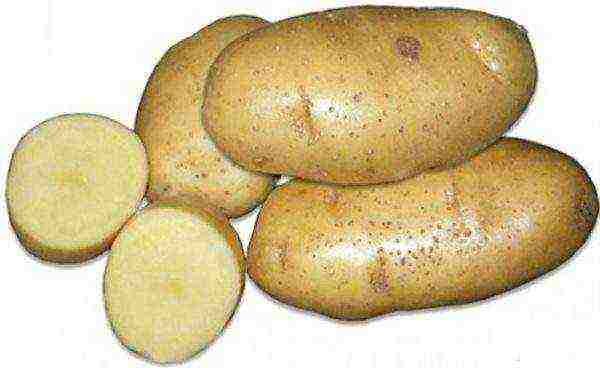
The Udalets variety is characterized by a high yield and excellent keeping quality.
- Nevsky;
- Sotochka.
The last two varieties will be discussed in more detail below.
Early potato varieties for Siberia
Early-ripening potatoes are less productive than autumn varieties, are stored worse and suffer more from diseases and pests. Early varieties are more demanding to care for than others. But all these disadvantages are paid off by obtaining fresh products in the shortest possible time.
The following early potato cultivars are popular in Siberia:
-
Priekulsky early (Latvian selection). The taste of this potato is satisfactory, the average tuber weight is 100 g. The first tubers can be dug out already on the 60th day after planting. In the conditions of Western and Eastern Siberia, after the complete withering away of the tops, the variety shows a yield of 350 centners per hectare. The tubers are oval, milky in color, the eyes are small, the skin is smooth, the flesh does not turn black when cut. The cultivar is strongly affected by late blight, but by the time the disease spreads massively, the crop usually has time to form.

Variety Priekulsky early ("forty days") is a champion in early maturity in Siberia
-
Zhukovsky early. A table variety, bred in the Moscow region, is considered the standard for early potatoes. 2 months after planting, it gives up to 120 c / ha of marketable tubers, the yield during harvesting is 450 c / ha. The cultivar is resistant to nematodes, scab, rhizoctonia. The tops and tubers are moderately affected by late blight. The tubers are oval with small eyes, the skin is pink, smooth, the flesh is white. The tubers of this variety do not boil over. They are very tasty "in their uniforms", suitable for making salads, as after cooking they are easily cut into pieces.
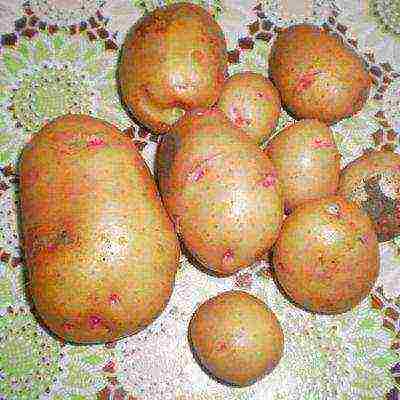
Zhukovsky early is recommended for the Tyumen region, but it is successfully grown in other Siberian regions.
-
Alena is a very popular variety in Siberia. It was bred in the Moscow region, but the patent for it was acquired by the Omsk SibNIISKhoz. The cultivar is recommended for growing in the Novosibirsk and Omsk regions. The average weight of tubers is 90–160 g. The color of the skin is red, the flesh is beige. The potato tastes good, is moderately soft, does not darken. The variety is excellent for preparing hot meals and processing into chips. Productivity - 170-200 centners / ha, in some years it reaches 400 centners per hectare. Potatoes can be dug out 60–70 days after germination. When harvesting tubers in the middle of the growing season (45-50 days), the Alena variety shows a yield of 150 centners per hectare. Potatoes are moderately resistant to viruses and late blight.

Alena's potatoes tolerate the absence of moisture and hot weather well, while ensuring a stable harvest
- Rosara is an early-maturing universal cultivar, bred in Germany. Ripens a week later than the first early varieties. The maximum yield is 415 c / ha. Rosara is resistant to cancer and nematodes, rarely affected by late blight and scab. It doesn't matter if the summer is dry or rainy - if you plant Rosara, you will not be left without a "second bread". At the same time, there is no need to frequently update the planting material, since the yield does not fall for 4–5 years. Rosara's tubers are oblong, leveled in size, well stored and perfectly tolerated during transportation. The skin is red, the flesh is yellowish. The average mass of potatoes is 80–120 g. Tuber crops contain about 15% starch, therefore they do not boil during cooking, but they have a good taste. Suitable for boiled dicing (for salads, vinaigrette), soups, frying and drying.
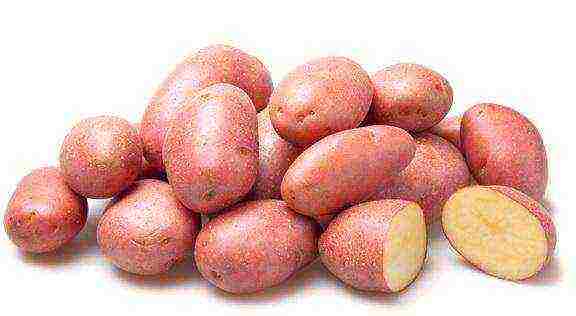
Rosara gives an excellent harvest regardless of weather conditions
Mid-early and mid-season potatoes for Siberia
In Siberia, mid-early and mid-season varieties are the basis of the harvest. They keep well and are therefore recommended for autumn and winter consumption. This group includes:
-
Svitanok Kiev is an old mid-early variety. Its main advantage is its outstanding taste characteristics.The starch content in the tubers reaches 19%, the potatoes are very soft, therefore ideal for making mashed potatoes. Svitanok Kiev is well stored, gives rather large tubers, the yield of the variety in Siberia is above average. Does not suffer from cancer, moderately resistant to late blight, can be affected by a nematode. The cultivar is recommended for cultivation in the Omsk, Tyumen and Novosibirsk regions.
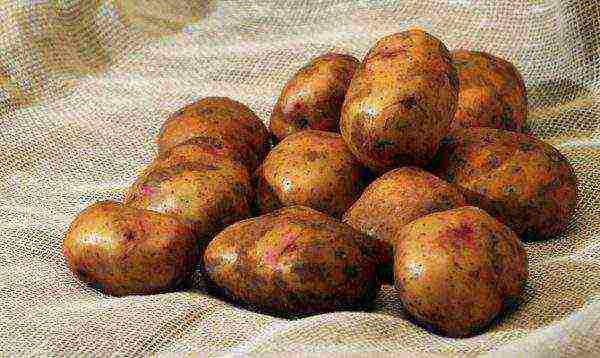
Svitanok Kiev potatoes are always popular due to their taste
-
Hostess. The variety was bred in the city of Tomsk (Siberian Research Institute of Agriculture and Peat), it is recommended for the regions of Novosibirsk and Krasnoyarsk. The average weight of a marketable tuber is 140 g, the maximum yield is more than 380 c / ha. Potatoes of this variety can be used to make mashed potatoes and crispy chips. In early spring, when the carbohydrate content in the tubers decreases after a long storage period, the Hostess becomes suitable for frying and cooking soups. The tubers are round, with a reddish skin and creamy flesh. The cultivar is resistant to cancer and nematodes.
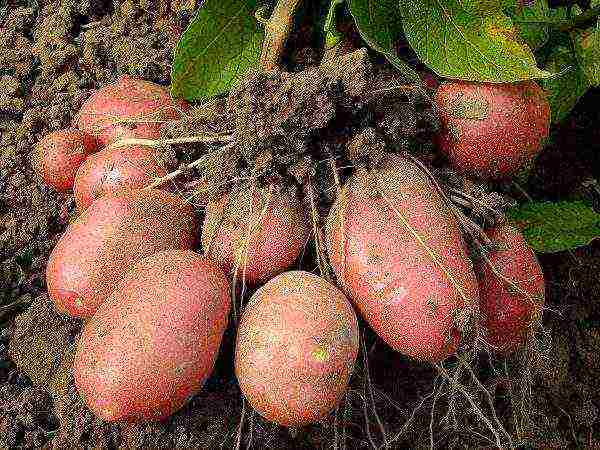
Hostess potato tubers contain a large amount of carbohydrates, so they have an excellent taste
-
Nevsky is a mid-early variety bred at the Vsevolzhskaya selection station in the seventies of the last century. Although many new varieties have now appeared that surpass Nevsky in yield, it is still recommended for cultivation in a number of regions of Russia, including Tomsk, Omsk, Novosibirsk, Irkutsk and Krasnoyarsk. The advantages of the variety are resistance to cancer, relative resistance to late blight. Nevsky is exceptionally harvestable, in different years it is possible to collect from 38 to 50 tons per hectare. Tubers ripen 80–95 days after germination. The average fruit weight is about 110 g. The tubers are oblong, with white pulp and thin yellow skin, covered with few small eyes. The cultivar is intended for dining purposes, the taste is satisfactory. Potatoes of this variety do not boil well, therefore they are of little use for mashed potatoes, but they can be used for soup, fried, and baked.
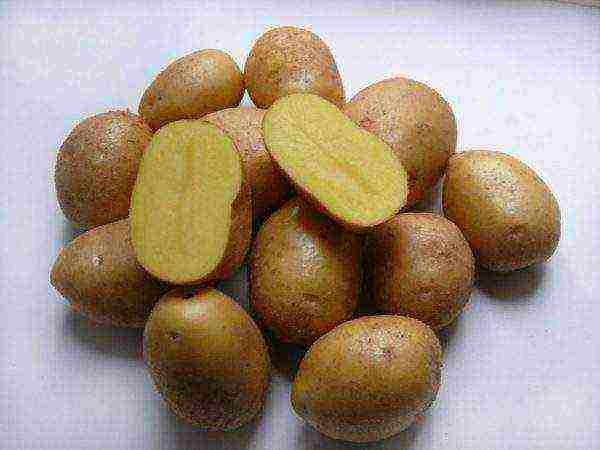
Nevsky is a champion in yield in Siberia
-
Adretta is a mid-early variety that is grown in all regions of Siberia, despite the fact that it has not been in Rosreestr for a long time. This potato is immune to cancer, rarely suffers from viral diseases, but is prone to late blight and scab. Round-oval tubers with a yellowish peel and pulp, weighing up to 150 g. Potatoes of this variety contain a lot of starch (up to 18%), therefore they boil quickly and are suitable for mashed potatoes. Productivity is high, keeping quality is satisfactory.
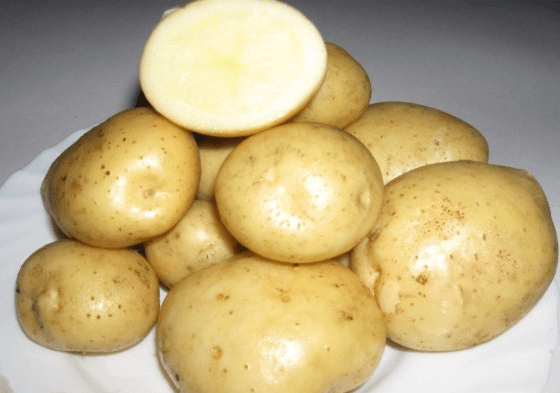
Adretta is appreciated for its taste, the puree from it turns out to be crumbly, of a beautiful yellow color
- Sante is a potato bred in the Far East. The variety is medium early, universal, gives a good harvest of marketable tubers, which lie for a long time in winter. Sante rarely suffers from cancer and potato nematodes, he is not afraid of late blight and viruses, but in some years he is strongly affected by scab and rhizoctonia. The tubers are large, oblong, covered with a yellow rind, under which the flesh of a yellowish tint is hidden.

Variety Sante is very stable, recommended for cultivation in the Tomsk and Tyumen regions
Siberian varieties
In Siberia, breeders are engaged in the development of new varieties of potatoes, adapted to local climatic conditions. Among the new products, the following can be noted:
-
Epic of Siberia. In 2016, the cultivar was transferred for state variety testing. Potatoes are of medium ripening, capable of producing a high yield even in arid conditions. The pulp and skin are light. The tubers are suitable for frying, mashed potatoes, soups and crispy potatoes.
-
Triumph is an early ripe cultivar with light skin and pulp. It was bred in Omsk together with the SeDeK agricultural company, in 2017 it was submitted for testing. The new variety is highly marketable.Has shallow eyes and even tubers, even if the crop is grown on heavy lumpy soil. The amount of starch is medium, the pulp is slightly crumbly.
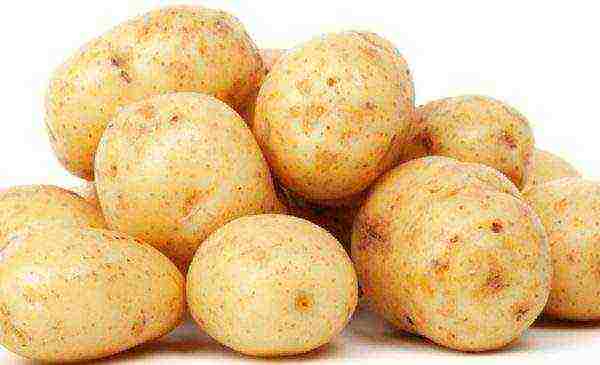
The Triumph variety is distinguished by high commercial quality of fruits.
-
Sotochka. This variety entered the State Register in 2013, bred in Omsk. Resistant to cancer, but susceptible to golden nematodes. The variety is mid-season, table variety, the maximum yield is 465 c / ha. The skin of the fruit is reticulate, reddish, the pulp is light, yellowish. Potatoes are good for all kinds of dishes.
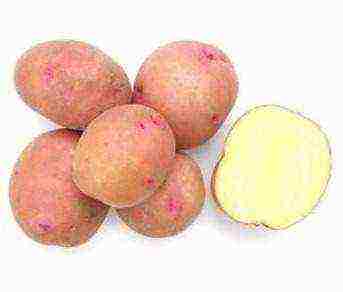
Sotochka potatoes have high commercial qualities and are characterized by good keeping quality.
-
Lina. A mid-early variety, bred at the Siberian Research Institute of Plant Production and Breeding, Siberian Branch of the Russian Academy of Agricultural Sciences. The cultivar is not new and has already managed to fall in love with many potato growers. Recommended for growing in Krasnoyarsk, Tyumen, Novosibirsk, Omsk, Irkutsk. Its main advantage is its high yield, which in some years reaches 500 centners per hectare. In addition, the Lina variety is characterized by a high starch content - up to 18%. Relatively resistant to nematode, late blight, tolerates drought and prolonged rains well.

Lina potatoes are well adapted to unfavorable conditions and have a high yield
Video: which potatoes are the most productive
Rating of varieties by taste
The yield per one hundred square meters or hectare is an important characteristic of potatoes, but taste is no less important. To determine the taste characteristics, tubers are steamed without salt. The results can be judged by comparing the following characteristics:
- Looseness - the more starch in the tubers, the looser they are. The starch content of potatoes ranges from 10% (Nevsky) to 25% (Lazar). Vegetables with a high starch content are not only tastier, but also healthier, as they contain more minerals that the body needs.
- Smell - boiled tubers should have a noticeable potato aroma.
- The consistency is hard, soft, watery.
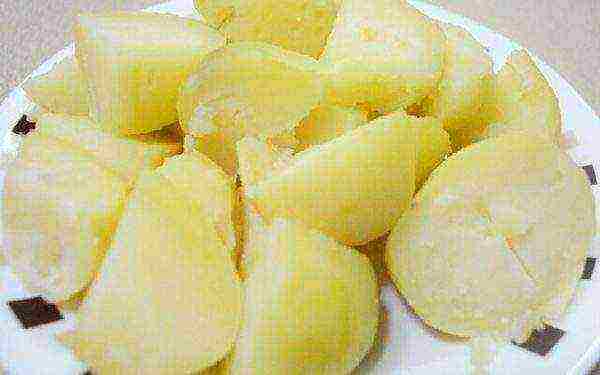
Loose potatoes contain a large amount of starch and other useful substances
The taste of potatoes is a subjective concept. It is determined collectively at tastings held in various organizations related to the study and variety testing of potatoes.

At tastings, you can evaluate and compare the taste of different varieties of potatoes
In 2016, 10 cultivars were tasted in the Omsk club of potato growers. Agria got the highest score (4.8 out of 5). The rest of the varieties are arranged as follows (in descending order of taste):
- Unique;
- Hostess;
- Knapweed;
- Epic;
- Alyona;
- Scarlet Dawn;
- Adretta;
- Karatop;
- Red Scarlett.
Features of growing potatoes in Siberia
The agricultural technology of Siberian potatoes is somewhat different from the technology of growing this crop in other regions of Russia and the countries of the former USSR. The soil here warms up late, so planting does not begin until May, and in the eastern regions of Siberia - at the end of spring. If potato growers of the middle lane have the opportunity to dig in early potatoes already in June, then in Siberia, meanwhile, shoots are just emerging. None of the techniques, including vernalization, help to noticeably accelerate the appearance of green shoots.
Potatoes can be planted when the ground warms up to a depth of 15 centimeters. The soil temperature should be at least 8 degrees.
A month before planting, tubers are taken out of storage for germination. This technique is very important, since in the conditions of a short northern summer, plants must quickly rise and have time to receive the energy of the sun. Tubers with already appeared sprouts and root buds are planted on the beds.
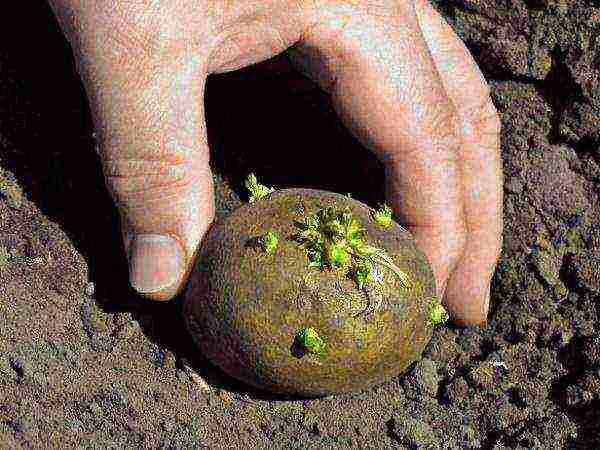
In Siberia, planting sprouted potatoes is an important condition for obtaining a good harvest.
Planting methods
In Siberia, potatoes are planted in several ways:
- one-line,
- tape,
- comb.
The one-line method is the most common. The tubers are planted in a row at a distance of 25–30 cm from each other, leaving 60–70 cm between the rows.With this planting method, potatoes can be planted shallowly - to a depth of only 10 cm - since hilling will be carried out later.

When planting potatoes in a single line, the distance between the rows is 60-70 cm
Tape planting is used for industrial cultivation. The potatoes are planted in two rows. The distance between the rows is 30 cm, the gap between the ribbons is 110 cm. With this method of planting, hilling can be carried out with a tractor, the roots of the plants are not damaged.

With the strip method, potatoes are planted in double rows
Ridge landing is used in areas where there is a lot of rainfall or groundwater is close to the soil surface. The ridges are artificially raised to a height of 20 cm, leaving 70 cm between the rows. This method of planting allows you to harvest an early harvest on waterlogged and heavy soils.
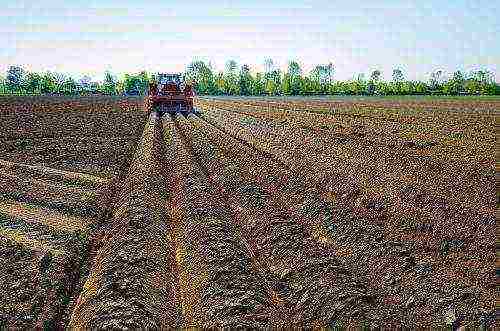
Potatoes are planted in ridges where water comes close to the soil surface
Watering
The amount of water greatly affects the size and quality of the potato crop. Throughout the growing season, it is necessary to carefully monitor the moisture content of the soil. In the dry season, you have to supply water to the site at least 5 times:
- For the first time, the potatoes are watered 2 weeks after the mass emergence of shoots.
- The second important period is plant budding. The approximate watering rate at this time is about 7 liters of water for each plant.
- If the ground becomes dry at a depth of 7 cm, then the plantings need to be additionally moistened.

Drip irrigation is the most economical way of watering potatoes, which requires a minimum of physical costs.
The next day after moistening, the soil is loosened, at the same time weeding the aisles and rows.
Hilling potatoes
Even in the south of Siberia in June there are often severe frosts on the soil. Rows with not yet emerged potatoes are preferably mulched with cut grass or other plant residues. Before the emergence of seedlings, the field is not weeded, so as not to accidentally damage future seedlings.

After planting, it is advisable to mulch potato ridges in order to protect the seedlings from frost
While potato seedlings have not yet appeared on the surface, the area can be sprayed with Roundup to destroy perennial and annual weeds.
The first hilling is carried out immediately after germination. It allows you to achieve three goals at once:
- cover the plants with soil to protect them from night frosts;
- rid the plantation of weeds;
- loosen the soil and thus improve the aeration of the roots.

The first hilling of potatoes is carried out immediately after germination
The second hilling can be started when the plants have reached a height of 15–20 cm.
Pest control
In Siberia, potato tubers are harmed by the Colorado potato beetle and wireworm. There is no bear in the region - a pest that annoys potato growers in more southern regions.
They get rid of harmful insects with the help of chemicals, such as:
- Prestige;
- Aktara;
- Force;
- Bankole;
- Eplace Quantum.
In personal farms, the Colorado potato beetle is harvested by hand.

Colorado beetles are harvested by hand in small areas
Photo gallery: preparations for protecting potatoes
Harvest
Early potatoes in Siberia are harvested from mid-August, other varieties - from mid-September to the second week of October. The tubers are dug out when the stems begin to dry out. A week or two before harvesting, the potato tops are mowed to protect the tubers from late blight. This technique also contributes to better storage and transportation of the crop, since after mowing the leaves, the skin on the tubers becomes coarser.

One to two weeks before harvesting, the tops of the potatoes are mowed to protect the tubers from diseases.
Reviews of gardeners
The climate and soil of Siberia are completely suitable for growing potatoes. The culture feels good in this region, shows a high yield (200-300 c / ha, and some varieties - up to 500 c / ha). In Siberia, varieties of mid-early, early and mid-season ripening can be grown.
The State Register contains quite a few varieties of potatoes for Siberia. It is for cultivation in the West Siberian region that 53 varieties are intended. It is these varieties, adapted, zoned, carefully selected taking into account all natural conditions for this region, and should be grown by Siberian gardeners in their personal subsidiary plots.
Among the new products is the Sarovsky variety, (characteristics - below in the text)
West Siberian region:
- Altai region
- Kemerovo region
- Novosibirsk region
- Omsk region
- Altai Republic
- Tomsk region
- Tyumen region
Potato varieties for Tyumen, Tomsk, Novosibirsk, Omsk, Kemerovo regions and Altai
- PRIOBSKY
- ERMAK IMPROVED
- ADRETTA
- SITANOK KIEVSKY
- LUGOVSKY
- ARCHITECT
- SANTE
- SAROVSKY
- KEMEROVCHANI
- ZHUKOVSKY EARLY
- NORTHERN
- PUSHKINETS
- CHRISTMAS
- FRESCO
- IRBIT
- TANAI
- SOTOCHKA
- METEOR
- JNA
- KRASNOYARSKY EARLY
- NIKULINSKY
- KAMENSKY
- ZEKURA
- ROSARA
- CHARM
- ANNIVERSARY
- KUZNECHANKA
- SAFO
- Hostess
- TOMICH
- SEPTEMBER
- KETSKY
- LINA
- LAZARUS
- Karatop
- NAKRA
- VALENTINE
- Ladoga
- RYABINUSHKA
- BARON
- TULEYEVSKY
- SOLAR
- REMOVER
- SARMA
- ALYONA
- ANTONINA
- RED SCARLETT
- AROSA
- STEMLUK
- IN MEMORY OF ROGACHEV
- ROKO
- LEADER
- LYUBAVA
A new variety of potatoes for Siberia - SAROVSKY
Variety of early ripening, table purpose, intended for cultivation in personal subsidiary plots.
The bush is of medium height, semi-erect. Leaves are medium, green.
Productivity 112-247 kg / ha.
Red tubers, oval-rounded, eyes of medium depth. The pulp is yellow. Average tuber weight 93-147 g. Starch content 13.9-18.4%. The taste is excellent. Marketability 83-98%. Keeping quality is good, 96%.
The variety has shown resistance to pathogens:
- potato crayfish
- golden potato cyst nematode
- wrinkled mosaic
- rolling leaves
But it is susceptible to the causative agent of late blight.
| North-West region (for the Vologda, Kaliningrad, Kostroma, Leningrad, Novgorod, Pskov, Tver and Yaroslavl regions) | Northern region (Arkhangelsk, Murmansk, Komi, Karelia) |
| North Caucasian region (for Krasnodar Territory, Rostov Region, Stavropol Territory, Adygea, Chechnya, Ossetia, Ingushetia, Dagestan, Circassia and Kabardino-Balkaria) | Lower Volga region (Astrakhan, Volgograd, Saratov, Kalmykia) |
| Middle Volga region (for Penza, Samara, Ulyanovsk regions, Mordovia and Tatarstan) | West Siberian region (for Tyumen, Tomsk, Novosibirsk, Omsk, Kemerovo regions and Altai) |
| Ural region (potato varieties for Orenburg, Chelyabinsk, Kurgan regions and Bashkortostan) | Far East (for Amur, Magadan, Sakhalin regions, Kamchatka, Khabarovsk Territory and Primorsky) |
| Central Black Earth Region (for Belgorod, Voronezh, Kursk, Lipetsk, Oryol and Tambov Regions) | East Siberian region (for the Irkutsk region, Krasnoyarsk region, Transbaikalia, Buryatia, Yakutia, Khakassia) |
| Central region (for Moscow region, Moscow, Bryansk, Vladimir, Ivanovo, Kaluga, Ryazan, Smolensk and Tula regions) | Volgo-Vyatka region (for Kirov, Nizhny Novgorod, Sverdlovsk regions, Perm, the Republic of Mari El, Udmurtia and Chuvashia) |
Good luck to you!
(Visited 1,476 times, 12 visits today)
loading ...
Post navigation
Varieties of vegetables and agricultural crops, recommended and zoned in the Kemerovo region according to the literature for 1967.
KEMEROVSK REGIONZones of the region and distribution by zones of administrative districts.I. Subtaiga of the foothills. Districts: Belovsky (eastern and southwestern parts), Izhmorsky (northern part), Kemerovo (subtaiga part), Krapivensky, Mariinsky, Novokuznetsk (subtaiga part), Prokopyevsky (north-eastern and southwestern parts), Tisulsky (northern part ), Tyazhinsky, Chebulinsky (northern part), Yurginsky (northern part), Yaysky (northern part) and Yashkinsky.
II.Northern forest-steppe foothills. Districts: Belovsky (central part), Kemerovo (forest-steppe part), Leninsk-Kuznetsky, Novokuznetsk (forest-steppe part), Prokopyevsky (central part), Promyshlennovsky, Topkinsky and Yurginsky (southern part).
III. Taiga of mountains and foothills. Districts Izhmorsky (southern part), Kemerovo (mountain forest part), Mariinsky, Novokuznetsk (mountain forest part), Tisulsky (southern part), Chebulinsky (southern part) and Yaysky (southern part).
Varietal zoning by cropsWinter rye... Zone I: a) for the open parts of the districts of Omsk; b) for parts of areas with sufficient snow cover - Vyatka. Zone II: Omka, Vyatka. Zone III: Vyatka.
Spring wheat... Zone I: a) for the taiga and forested parts - mid-early - Skala; mid-season - Diamond; b) for the open part - mid-early - Skala; mid-season - Lutescens 758, Diamant. Zone II: mid-early - Skala; mid-season - Lutescens 758, Saratovskaya 29, Kharkovskaya 46; late ripening - Milturum 553. Zone III: early ripening - Narymskaya 246.
Oats... Zone I and III: Golden shower. Zone II: Victory.
Spring barley... By region; Wiener, Kasticki.
Millet... In the region: Kazanskoe 506, Kamalinskoe 40.
Buckwheat... For buckwheat cultivation areas: Kalininskaya.
Peas... By region: Torsdag.
Mustard... Zone II: Non-sagging 2.
Ryzhik... Zones I and II: Voronezh 349.
Makhorka... For areas of makhorka cultivation: АС 18/7, Malo-stepsynkovy pekhlets 4.
Potato... By region: early maturing - Epron; middle late - Verlichingen (crustacean), Kemerovo, Lorkh.
White cabbage... In the region: early ripening - Kuusiku varayane, Number one polar K-206; mid-early - Stakhanovka 1513; mid-season - Slava Gribovskaya 231, Slava 1305; mid-late - Gift, Belarusian 455.
Red cabbage... Area: Stone Head 447.
Cauliflower... By region: Early Gribovskaya 1355.
Salad... By region: Khrustalny.
Spinach... By region: Gigantic.
Cucumbers... In the region: Muromsky 36, Altai early 166, Vyaznikovsky 37, Rzhavsky local; in addition, for zones I and II - Unbearable 40; for greenhouses - Multiparous VSHV, Klinsky local; for greenhouses - hybrid VIR 502.
Tomatoes... In the region: Alpatieva 905-a, Talalikhin 186, Siberian early maturing; for autumn-winter greenhouses - Uralsky multifruit; for winter-spring greenhouses - Leningradsky early ripening, Uralsky multiparous; for greenhouses - Siberian early maturing.
Onions on a turnip... By region: crop from the sample - the best local varieties; two-year culture from sevka - Bessonovsky and Strigunovsky local; annual seed culture - Annual Siberian, Strigunovsky local; from seedlings - Kaba, Annual Siberian, Strigunovsky local.
Bow on a green feather... By area: batun, chives.
Garlic... By region: the best local varieties.
Table carrot... In the area: Nantes 4, Chantenay 2461.
Table beet... In the region: Siberian flat 167/367, Bordeaux 237.
Turnip... In the region: Petrovskaya 1, Milanskaya white red-headed 283.
Dining rutabaga... By region: Krasnoselskaya.
Radish... By area: Winter round black.
Radish... By area: Rose red with a white tip, Ruby.
Parsley... By region: Sugar.
Parsnip... By area: Round.
Sugar peas... Zones I & II: Inexhaustible 195.
Shelling peas... By area: Early canning 20/21, Early maturing brain 199.
Beans... By area: Russian blacks, Windsor whites.
Sweet pepper. By region: Novocherkassky 35.
Hot pepper... In the region: Astrakhan 147.
Pumpkin... By area: Almond 35.
Zucchini... By region: Gribovskie 37.
Corn... In the region: early maturing - hybrid Bukovinsky 2 (Bukovinsky 2T); mid-early - hybrid Bukovinsky 3
(Bukovina ZTV); admit to sowing - medium late - Sterling.
Vika... Zones I and III: Kamalinskaya 611, the best local varieties. Zone II: Lgovskaya 31-292, the best local varieties.
Panic... In the region: admit to sowing - Omsk-10.
Chumiza (for hay). By region: admit to sowing - Novosibirskaya 1.
Kale... By region: Brain green Vologda.
Alfalfa... Zones I (for areas of alfalfa cultivation) and II: Marusinskaya 425, Kuzbasskaya.
Clover... By region: for areas of clover cultivation - Tomsk, Asinovskiy, Biyskiy and other best local single-cut varieties.
Awnless bonfire... Zones I (for areas of awnless bonfire cultivation) and II: Morshanskiy 760.
Fodder carrots... In the area: Karsun improved M-15, Shantene 2461, Guéranda.
Fodder beet... By region: Arnim Krivenskaya.
Fodder rutabaga... Zones I and II: Swedish, Krasnoselskaya local, Hoffman. Zone III: Swedish, Krasnoselskaya local.
Turnips... By region: Ostersundomsky, Bortfeldsky.
Fodder squash... By region: Gribovskie 37.
Table of contents



